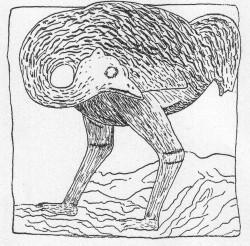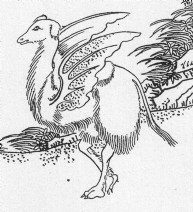

To next page
Yang Xiu and Song Qi :Xin T'angshu
(New history of the Tang Dynasty) (1060)
---------------------------------------------------
-The first big paragraph taken from: East Asian History Source Book (internet), the last
big paragraph from Teobaldo Filesi; China and Africa in the Middle Ages.
The small paragraphs about donations of zanj to the emperor are taken from Edward H. Schofer: The Golden
Peaches of Samarkand
Also called Hsin-t'ang-shu or Ouyang Xiu
Crossing the desert in the south-west of Fu-lin,(byzantium) at a distance of 2,000 li there are two countries called Mo-lin and Lao-p'o-sa (or Laobosa). Their inhabitants are black and of a violent disposition. The country is malarious and has no vegetation. They feed their horses of dried fish, and live themselves on hu-mang (the Persian date Phoenix dactylifera). They are not ashamed to have most frequent illicit intercourse with savages; they call this establishing the relation between lord and subject. On one of seven days they refrain from doing business, and carouse all night.
The Zimzim.... practice incest and in this respect are worst of all the barbarians.
Note: Zimzim or Zemzem is in the strict sense the Zoroastrians of Persia, but in a wider sense all pagans.
These two fragments he took from the lost book of Du Huan, of which some more passages are found in Tu Yu (801). Also found in Tuan Ch'eng Shih (863) and Ma Tuan Lin (1295).
Note: Mo-lin must have been somewhere in the horn of Africa, Laobosa however is easily to identify with al-Habasha, (Ethiopia. )
Somewhere else in the book is noted:
This bird is commonly called camel-bird. It is seven feet high, black of color, its feet like those of a camel, it can travel 300 li a day, and is able to eat iron.
In AD 614 the envoys from Java brought two Seng-shi woman as part of the imperial tribute.
In AD 724 the ambassador of the ruler of the kingdom of Srivijaya offers a Seng-ki as tribute along with other exotic items.
In 813 the Javanese nation of Kalinga came to the court of Hsien Tung presenting four Seng-ki boys.
In 818 a shipment was brought to the Son of Heaven along with two Seng-ki girls and a live rhinoceros with a mission from Kalinga (in Java)
During the k�ai-yuan period (713AD-742AD) there came a mission to China from Shi-li-fo-shi (Sumatra) which, among other things, presented two dwarf women and two women from Song-li, also singers and dancers.
Sho-p�o country (java) sent in AD613 as tribute to China four Song-chi slaves.
The book also mentions an island called kat-kat sangi countri which was an island of the northwestern corner of Sumatra.
(Note I think that some of the above mentions of Sang-shi people are wrongly attributed to the New tang History)
See Note on Sangi Slaves
The book also repeats the following passage:
South west (of the Arabs) is the sea and in the sea are the tribes of Po-Pa-Li.(in Cantonese Put-pat-lik is a transcription of Barbarik) These tribes are not subject to any country. They do not cultivate grain, but live on meat and drink a mixture of milk and cow's blood; they do not wear clothes but cover their bodies with sheepskins. Their women are intelligent and handsome. The country produces a great quantity of ivory and incense, o-mo (in Cantonese o-mut is omur, standing for Persian Ambar). When merchants traveling from Po-ssi (Persia) want to go there for trade, they have to go in groups of several thousand persons, and after offering pieces of material and swearing a solemn oath (of blood) they proceed to do their business.
Taken from: Gustaaf Schlegel; Siamese Studies
Found in the "Nan-Man Chuan " which is the book on the Southern Barbarians in the New History of T'ang Dynasty
Notice of Sri-Bodji:
Sri-Bodji is situated 2000 chinese miles beyond the Gunturaug-mountains. The country extends itself 1000 miles from East to West, and 4000 miles and more from North to South. It counts 14 cities and is divided into two states. Its whole western part is called Lang-Baros (?). It produces much gold, cinnabar and camphor. A gnomon of eight feet high, erected on the day of the summer- solstice, casts its shadow 2 feet and 5 inches towards the South. There are many males in this country, and there is found a kind of camel with spots like a leopard, and horns like a rhinoceros, which animal is used for riding and ploughing. It is called Camel-ox-leopard.
There is, besides, an animal resembling a hog, with horns like a wild goat, which is called Ubah (or Ujiok).
---------------------------------------------------------------------------------------------------------------------------